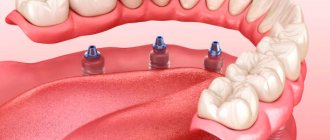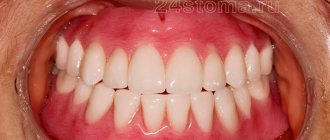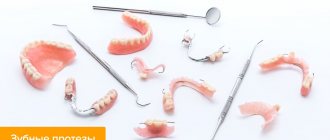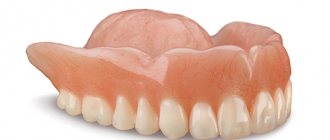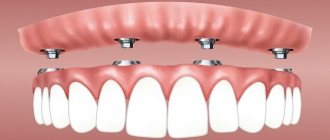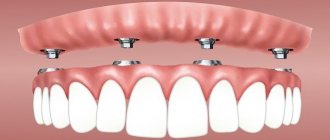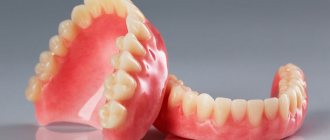- Work examples
- Questions and answers
- Stock
- Reviews
Modern dentistry offers a large number of different types of prostheses for restoring damaged teeth - the doctor selects the necessary design for each patient. Many patients have heard about telescopic prostheses, but do not quite understand what they are - in this article we will try to explain how telescopic prosthetics differs from conventional ones.
There are removable and non-removable (bridges, implants) dentures. Telescopic crowns are removable. Despite the fact that permanent structures, due to their name, may seem more durable, telescopic fastening of a denture in the oral cavity can last a very long time and provide a complete replacement of a lost tooth.
Why are dentures on telescopic crowns recognized as the most comfortable among removable structures?
Article navigation
- What are the features of the system
- The main indications for the installation of such prostheses
- How the system is designed and attached
- Types of telescopic crowns
- How are dentures made?
- Why choose a telescopic system
- How to care for dentures on “telescopes”
- Estimated cost of prosthetics
- An alternative to telescopic structures
- FAQ
Question for a specialist
Many patients strongly associate removable dentures with grandma’s false jaws, which need to be placed in a glass at night.
But today such an idea is outdated: not only should such structures not be kept in a humid environment outside the oral cavity, but they also have more comfortable analogues. In terms of aesthetics and convenience, prostheses mounted on telescopic crowns are the leaders. Today, such products are increasingly preferred by both the older generation and young people who are faced with the serious problem of tooth loss. Read about in what cases such prosthetics are recommended and what telescopes have to do with it in today’s material.
Tooth extraction, bone grafting and gum grafting
While under sedation, the patient had six teeth removed and the gums around some teeth were corrected. The operation lasted two hours.
Sedation is a type of anesthesia in which the patient breathes on his own, and can even follow the doctor’s instructions, but at the same time his state is like in a dream, there is no pain, no unnecessary worries, the patient is relaxed and calm. The anesthesiologist monitors the patient's condition throughout the operation. The clinic has a separate room where you can rest after surgery.
View after tooth extraction:
The main indications for the installation of such prostheses
Today, dentists use telescopic crowns if there are the following indications:
- loss of a large number of teeth: the prosthesis can replace several adjacent elements,
- the poor condition of the remaining units: that is, it is obvious that they will soon have to part with. After their loss, the design can be adjusted.
However, installation of such systems is not possible in all cases. Among the contraindications are the inclined position of the teeth, their abrasion of degrees 2 and 3, and individual intolerance to the materials of the product.
Osteopath consultation
Osteopathic diagnostics showed that there is a strong imbalance to the right. Impaired body balance and muscle function must be corrected before prosthetics begins, so that prosthetics are comfortable and do not harm the temporal joints (read about the relationship between bite and body balance here). The work of an osteopath helps with any change in bite (orthodontically or with the help of prosthetics), as tension is reduced, headaches and neck pain are eliminated. In this case, the osteopath will begin treatment by conducting several sessions with an interval of 10 days. Once the condition has stabilized, dental prosthetics can begin.
How the system is designed and attached
A prosthesis with telescopic crowns belongs to the clasp type, where the base is a metal frame. The orthopedic system includes 2 components:
- fixed part: represented by a crown resembling a thimble in shape. It is firmly attached to the supporting element using medical cement. Some sources and experts also call it a telescopic system if the structure is attached to implants. However, it is still most correct to consider this term specifically in relation to removable dentures, because a denture on implants is a completely different technology,
- removable part: in fact, the clasp prosthesis itself, into which a second crown with a “pit” is inserted, that is, a recess.
When connecting the parts, the second is put on the first, implementing the principle of a telescope. Thus, the product is firmly fixed. The removable part of the system can be removed from the mouth without much effort.
Dental treatment under a microscope
In order for dental prosthetics to be durable, before covering the teeth with crowns, you need to make sure that the teeth are healthy, there is no infection in the canals, and caries has been cured. In this case, after an inspection with a microscope, it became clear that it would be necessary to remove not five, but seven teeth, since it was impractical to re-treat the canal in the central tooth and treat one of the lower teeth. Treatment of caries on the upper tooth was performed.
During treatment, the temporary denture of the upper teeth was removed and then put back in place, meaning the patient never went a day without teeth!
Types of telescopic crowns
Telescopic type crowns come in different shapes:
- cylindrical: the walls of the removable and non-removable parts are located parallel. This causes mutual sliding and traction is difficult to maintain. Suitable exclusively for teeth without periodontal pathologies. Extremely difficult to manufacture, therefore rarely used,
- conical: used for any indication for removable prosthetics. Due to the shape, they fit more tightly to each other, while taking off and putting on the prosthesis is quite easy - you don’t have to worry about skewing or jamming. During manufacturing, the individual angle of the cone is taken into account so that the removable part does not fly off randomly. This is possible due to viscous food or tongue, if serious errors were made in the production of the product.
It is not recommended to remove the structure too often, especially since this is not necessary. It is enough to do this once every 2-3 months to perform hygiene procedures.
PROSTHETICS WITH 6 OSSTEM IMPLANTS FROM RUB 200,000.
Complex implantation Osstem (South Korea) with delayed loading after 4-6 months.
Call now or request a call
Treatment plan
All questions about the cost of various treatment options and timing were explained to the patient. A treatment plan and estimate were drawn up.
- Treatment by an osteopath, 2 sessions, elimination of muscle imbalance.
- Removing the metal bridge and replacing it with a temporary prosthesis.
- Re-treatment of the canal in the central front upper tooth, treatment of caries (canine on the upper jaw on the right), revision of teeth under crowns, if necessary, treatment of teeth under a microscope.
- Removal of 5 teeth (two on the upper and three on the lower jaw), correction of the level of bone and gums on the upper jaw - under sedation.
- A month after the extraction, installation of telescopic crowns on 10 teeth and prosthetics of the teeth with telescopic removable dentures.
- Selection of hygiene products, training in hygienic care of telescopic dentures.
The preliminary cost of the work is 976,234 rubles. Approximate duration: 6 months. Payment will be made in stages, installment payments are possible.
How are dentures made?
The telescopic crown of the tooth and the frame of the structure are made of palladium, gold, and cobalt-chromium alloys - ideally, both parts of the system should be made of the same material. The use of precious metals increases the cost of the product, but it ensures higher strength and also eliminates the risk of allergic reactions.
On a note! The latest word in dentistry is the use of galvanic technology. The structures are made from an alloy of base metals or zirconium dioxide, and gold is applied to the outside. The surface is covered with composites.
If telescopic crowns are recommended, the fabrication and installation steps may take more than a month in total. The process includes:
- history taking and examination: the doctor finds out the condition of the patient’s teeth, bite characteristics, allergic status and other nuances. The most important stage is the selection of supporting elements. The dentist will have to assess whether they can withstand the load. Errors in selection are fraught with loosening of elements and their further loss,
- production of the structure: first, impressions are taken from each jaw, from which dental technicians make a model. Then the blank is tried on in the patient’s mouth and adjustments are made. Next, the workpiece is again sent to the laboratory, where it is brought to perfection,
- preparation of supporting elements: if necessary, they are treated. Then the orthopedist grinds down the teeth and installs permanent crowns. After this, the telescopic crowns of the removable part are fixed.
Don't know what type of prosthetics to choose?
We will help in the selection, advise where to read more information and compare types of prosthetics.
Consultation with an orthopedic doctor in Moscow clinics is free! Call now or request a call
Working hours: from 9:00 to 21:00 - seven days a week
The production of such products is a complex and labor-intensive task, requiring highly qualified specialists. Even small deviations from technology can lead to negative consequences. In addition, the system is quite expensive, so the patient expects to receive a truly high-quality product that will be a worthy alternative to removable dentures.
It usually takes no more than 3 days to make an internal crown. The removable part requires a longer period - up to 4 weeks. How long it will take to prepare the abutment teeth depends on their condition.
Temporary dental prosthetics in a new bite
About a month later, when the holes from the extracted teeth had healed, the patient was fitted with temporary dentures to get used to the new, higher bite in which the prosthetics would be performed. This is the most physiological bite in this case, in which the teeth, joints and muscles themselves will not experience overload.
Since the height of the bite has been changed, it is necessary for the muscles and joints to get used to the new work. At the stage of temporary dentures, it is possible to make the necessary adjustments, which will then be taken into account in the manufacture of permanent dentures.
Why choose a telescopic system
Among the undoubted advantages of such systems, experts note the following points:
- reliable fastening: the telescopic crown ensures complete immobility of the structure and eliminates the possibility of its falling out,
- uniform distribution of pressure on the supporting units when chewing: this prevents injury to the gums and has a good effect on periodontal tissues,
- accessibility of the spaces between the teeth when removing the prosthesis: allows you to fully perform hygiene procedures,
- the possibility of adjusting the products: this may be necessary if other teeth are lost,
- absolute aesthetics: thanks to the hidden fastening system, the prosthesis looks as natural as possible,
- strength: do not have open moving elements that could be broken.
Separately, it is worth mentioning the comfort of wearing such structures. They do not put pressure on the root of the tongue, so they do not cause a gag reflex. Dryness in the mouth is also not a threat, since the products do not close the salivary ducts. Another plus is the absence of a negative impact on diction.
Like any orthopedic solutions, telescopic systems are not without their drawbacks. The main one is the gradual atrophy of the jaw bone, which ceases to receive a full chewing load. This is a common disadvantage, characteristic of all prosthetic products.
Another disadvantage of telescopic structures is their high cost compared to other removable dentures. This is explained by the need to make 2 crowns for each abutment tooth. The exact amount will depend on the material of the product and the number of crowns.
Varieties
Devices are classified into the following types:
- cylindrical ones have a structure in which the prosthesis functions similarly to a piston. The result of the manipulation depends on adhesion and density;
- the most reliable cone devices, as they are less susceptible to inaccuracies and wear. The product is able to automatically take the correct position regardless of how they are placed.
The telescopic crown with friction pin creates a design with excellent performance and frictional force capability. The devices retain the ability of friction along the entire length. This means that they maintain their integrity and do not separate, which is observed with standard cone solutions.
How to care for dentures on “telescopes”
The products can be worn around the clock; they do not need to be removed at night. Caring for a prosthesis is simple, you just need to follow a number of rules:
- the removable part is periodically removed from the oral cavity and placed for disinfection in a soda-saline solution for 10-15 minutes. You can also use special solutions that are sold in pharmacies. It is important to understand that such a prosthesis is not completely removable, but conditionally removable, that is, it does not need to be removed too often; the entire system can be “lost”
- In normal times, hygiene procedures are carried out using the usual means: only pastes with abrasive particles that can damage the surface of the product are prohibited. It is recommended to use an irrigator, which will perfectly remove product residues from under the prosthesis,
- If the prosthesis needs to be removed for a long period of time, it should be cleaned, dried and stored in a plastic container at room temperature. Do not place the product in the refrigerator or keep it near a heat source - this will lead to its deformation.
Every six months it is necessary to visit the dentist in order to be able to identify possible problems in time and correct the design.
“I used an acrylic prosthesis for two years - during this time I experienced a lot of inconvenience, and especially when eating. In addition, the rigidity of acrylic constantly interfered. On the advice of the doctor, I installed a clasp prosthesis on telescopic crowns. I felt the difference immediately. I got used to it very quickly and now I hardly feel it. Almost like natural teeth!” Valentina, from correspondence on the dental forum
REPROSTHETICS WITH ACRYLIC PROSTHETICS - RUB 200,000.
Re-prosthetics with an acrylic bridge on a metal frame (all included) up to 12 units.
Save RUR 30,000. Call now or request a call
A telescopic dental crown and denture can theoretically last up to 10 years. However, practice shows that the actual period reaches a maximum of 4 years. After this time, the adhesive force of the crowns dries up, and they no longer fit tightly to each other.
Consultation with an orthopedic dentist
At the consultation, orthopedic dentist S.V. Zukor noted the absence of lateral teeth in the lower jaw and several teeth in the upper jaw. Due to the absence of teeth, the level of the bone has changed, and subsequently the level of the gum. Deformation is observed in both the bite and the smile. The patient notes physical discomfort on the right, where the teeth are partially destroyed. The remaining teeth are mobile and worn out. A stamped metal bridge for 5 teeth is installed on the left upper jaw. There is an average amount of dental plaque on the teeth. The gums are swollen and inflamed. There are pains and clicks in the temporal joints.
A computed tomography scan was performed to assess the condition of the tooth roots and bone tissue. The panoramic image, which was taken from a CT scan of the teeth, shows that due to the long absence of teeth, the bone of the lower jaw has become very thin, and the level of bone in the upper jaw under the bridge has been reduced. It is also clear that the canal of the central tooth is unsatisfactorily sealed, and there is inflammation at the root of the tooth.
For additional diagnostics, the patient was referred to an osteopath, since a change in bite always entails a violation of body position and muscle coordination.
Estimated cost of prosthetics
A prosthetic device on telescopic crowns is a fairly expensive option for removable prosthetics. The exact cost of manufacturing and installing the structure will depend on a number of factors, including the number of “voids” in the dentition, the material of artificial crowns, and the pricing policy of the dental center. So, one such crown can cost up to 20 thousand rubles. The cost of a prosthetic device will vary from 50 to 150 thousand - the more missing teeth, the higher the price.
Prices
| Service | Price |
| Consultation + treatment plan | For free |
| Telescopic crown | from 19,350 ₽ |
| Telescopic prosthesis | from 34,550 ₽ |
Expert of the article you are reading: Tseryabina Marina Anatolyevna Therapist
26 years
Clinical experience
Otradnoe
st. Khachaturyan, 7
+7 +7
Free consultation with this specialist
An alternative to telescopic structures
What can modern dentistry offer if a prosthesis on “telescopes” is not suitable for you for some reason? There are other methods of restoring teeth:
- removable products with clasps: seriously inferior to telescopic systems in aesthetics,
- clasp products with attachments (micro-locks): a good option, but not suitable if you have few teeth,
- nylon structures: inferior in terms of service life. In addition, they cannot be corrected in case of tooth loss,
- installation of implants: recognized as the best possible alternative, but much more expensive.
The choice of a specific method largely depends on the characteristics of the clinical picture, including the number of lost teeth and the financial capabilities of the patient. You need to understand that the best solution that will restore the appearance and full functionality of the dentofacial apparatus, as well as stop the atrophic processes in the jaw bone tissue, is dental implantation.
Indications and contraindications
This type of design is used if:
- units of the dentition are partially missing;
- it is necessary to replace the missing amount as naturally as possible (the prosthesis is aesthetically pleasing);
- teeth are at the stage of rapid destruction, there is a risk of loss (telescopic crowns in this case serve as a way to preserve and protect weak units);
- the patient does not want to install a structure that is difficult to remove from the oral cavity.
There are a number of contraindications for use:
- hyperabrasion of tooth enamel;
- incorrect location of the roots and crowns of the teeth that are planned to be chosen as supporting ones;
- pathologies that prohibit dissection of units.
The dentist may refuse to install a telescopic clasp denture if he diagnoses one of the periodontal tissue diseases! This contraindication is considered relative, since after eliminating the pathology, the doctor will allow the installation of this design.
FAQ
QUESTION: Good afternoon! I've been allergic since childhood. Is it dangerous for me to have telescopic dentures? Irina V., Saratov ANSWER: In general, various metals are used in such prostheses, including alloys containing nickel. If you are allergic to these materials, then this system will not suit you.
QUESTION: How do clasp prostheses on telescopes differ from conventional clasp prostheses? Nick, Moscow ANSWER: In the method of fastening. The removable clasp device is equipped with clasps for fixation on the supporting teeth. Telescopically installed on special double crowns. That is, they are already moving into the category of conditionally removable and are fixed much better. But again, they are not suitable for everyone - you need to consult a doctor.
QUESTION: Hello! I only have four of my teeth left. I want to install a telescopic prosthesis. How much is it? Ekaterina, Magnitogorsk ANSWER: It is not a fact that with so many teeth its installation is even possible. But if the doctor makes such a decision, then the total cost will include the price of 8 crowns (two for each tooth). The exact amount will depend on the materials used.
Tips for reducing discomfort during the adjustment period
In the first 3 to 4 weeks, the patient may experience some discomfort, manifested in deterioration of diction, rubbing of the mucous membranes, changes in the taste of food and drinks consumed, biting the tongue or cheek surface, and gagging.
Adviсe
:
- Doctors recommend moistening the surface with clean water before putting on the clasp construction in the first days;
- Tongue twisters will help bring your speech back to normal. Choose combinations that are difficult to pronounce and practice several times a day.
Minuses
Before undergoing the procedure, the patient must consider all the pros and cons and decide what suits him best, naturally with the doctor’s recommendation:
- if a person initially had a metal crown installed, sometimes it is visible in the supragingival part. It is recommended to use a special cap in a visible place to cover the defect;
- Many people do not like the technique because it requires grinding of teeth, which is why it is considered not gentle;
- every day a person must clean the structure to prevent caries, remove plaque and food particles;
- if the device is made using implants, then in the event of a breakdown it is necessary to completely redo the entire system;
- for installation you need to visit a specialist many times and take measurements;
- The technique costs a lot of money if you compare it with others.
In order to determine the exact cost of a prosthesis, many factors must be taken into account. As a rule, product prices directly depend on the quality of the material used in production. This applies to both individual parts of the prosthesis and retainers.
The level of the dental clinic and the qualifications of the staff working in it also affect the cost of prosthetics. At the same time, it is not worth saving on dental services, since the quality of the prosthesis is determined by the availability of high-tech equipment and the experience of doctors.


